Topic
Bioluminescence

Lights in the Dark: New Tools in the Search for Bioluminescence
Expedition: Galapagos Platform
By: Ariel Zych and the Ocean Exploration Trust Team
Complete blackness greeted the viewers of Nautilus Live for a time during an Ocean Exploration Trust Galapagos Expedition. All the lights on the remotely operated vehicles (ROVs) Hercules and Argus were turned off. Members of the exploration team searched the ocean with a new tool: a low-light camera capable of detecting bioluminescence. After sending two brief, bright flashes into the darkness, one of these filming sessions returned exciting footage of bioluminescence in a marine worm.
ROVs Hercules and Argus both had multiple cameras aboard, but they were not sensitive enough to detect the ocean’s dimmest light sources. “I’m interested in looking at everything, and this camera is the truest way that we can measure low light in the ocean,” said researcher Brennan Phillips. Phillips worked with Vincent Pieribone at the J.B. Pierce Laboratory at Yale University to adapt the camera for use with ROVs hoping to find new, unique examples of bioluminescent organisms.

Bioluminescence is light created and emitted by living organisms. The light emitted by organisms is created by a chemical reaction involving a special molecule called luciferin. The reaction results in the emission of photons (light energy). Bioluminescent organisms can be easily observed at the surface of the ocean and researchers have found them at depths of over 2,500 meters. However, little is known about the diversity of bioluminescent organisms and the wavelengths of light they produce.
Pieribone and Phillips have explored different regions of the ocean searching for bioluminescence at different wavelengths and intensities for possible future biomedical uses. For example, the proteins that cause bioluminescence can be used to visualize gene expression in living tissues.
Scientists are now working to identify a broader range of bioluminescent (and fluorescent) proteins to advance the field of gene expressionvisualization. “Different wavelengths allow for different tissues to be visualized. Finding new frequencies, or colors, of bioluminescence will give biomedical researchers more tools to work with,” says Phillips. “If we can find proteins that have other wavelengths, these researchers could create non-invasive imaging tools that could be embedded in a person – we could create signaling proteins deep within a person’s body.” This could be a powerful diagnostic tool, and possibly reduce the need for some surgeries or procedures currently used to examine the inside of the body.
The first step to finding these new frequencies is to search diverse ocean habitats for bioluminescent organisms and measure the wavelengths of light they produce. Phillips has taken the low-light camera on several different cruises to look for new organisms including the waters off New England and the Solomon Islands.
The hydrothermal vents near the Galapagos Islands also piqued his interest because vent bacteria have been found to have genetic sequences that code for luminescing protein. But a question was, do they actually produce light? After a few dives, Phillips was still unsure. The camera observed a single bright dot at a vent chimney, which was encouraging. “I’m not trying to collect the animals, I’m more interested in demonstrating that the camera can accurately measure levels of light,” Phillips said. “I was hoping to match light measurements from the actual vent with images of the bioluminescent animals that might be there. This is very hard to do, since you have to turn off all of the lights to see bioluminescence, but very often you can’t see the whole animal that’s making the light. We’re still figuring out the right way to do this,” Phillips said.
For more, take a look behind the scenes as Dr. Brennan Phillips describes how low-light cameras are tested to capture the light of bioluminescent animals.
Source files:
Original blog: https://nautiluslive.org/blog/2015/07/21/lights-dark-new-tools-search-bioluminescence
Expedition: https://nautiluslive.org/cruise/na064
Explorer (bio): https://nautiluslive.org/people/ariel-zych
Bioluminescence in a marine worm (video on webpage): https://nautiluslive.org/blog/2015/07/21/lights-dark-new-tools-search-bioluminescence
ROV Hercules (image): https://nautiluslive.org/sites/default/files/styles/responsive_image_xl/public/images/2019-04/rov_herc_on_crane.jpg?itok=A8Y6uWUv
ROV Explainer Graphic (poster): https://nautiluslive.org/resource/rov-explainer-graphic-poster
LEGO Brick ROV Hercules: https://nautiluslive.org/resource/lego-brick-rov-hercules
Brennan Phillips (image): https://nautiluslive.org/sites/default/files/styles/responsive_image_xl/public/images/2015-07/brennan_phillips.jpg?itok=0jABdJc9
Bioluminescence (video): https://www.youtube.com/watch?v=HKsG94ZXmGM
Green fluorescent protein (photo): https://nautiluslive.org/sites/default/files/styles/responsive_image_xl/public/images/2015-07/stage-14_drosophila_embryo_expressing_abda_and_exd_both_fused_to_one_half_of_the_ fluorescent_protein_venus_-_journal.pbio.1001349.g001.png?itok=tVfNl5fv
Galapagos Islands cruise (map): https://nautiluslive.org/cruise/NA064
Low Light Camera Captures Bioluminescent Animals (video): https://nautiluslive.org/video/2018/01/23/low-light-camera-captures-bioluminescent-animals